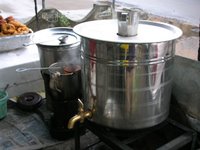 Thought that I would get coffee when I approached this beverage seller near the main Trivandrum railway station and I was pleasantly surprised to see that he was making tea. I was even more delighted at his ingenious way of making it.
Thought that I would get coffee when I approached this beverage seller near the main Trivandrum railway station and I was pleasantly surprised to see that he was making tea. I was even more delighted at his ingenious way of making it.He had a kerosene stove on which he had placed a large stainless steel (others had brass) vessel with a tap at the bottom (more like a vessel which one uses for storing water). This vessel had another vessel inside it. This the large vessel underneath stored the hot water and also acted as a double boiler for the small vessel which stored the milk. The lid also had a small hole, which kept a conical shaped stainless steel vessel, which  contained the tea infusion. So when you wanted tea he would put a little of the infusion through a sock shaped muslin, add sugar and milk and then open the tap to pour the hot water into a glass and voila the tea was ready.
contained the tea infusion. So when you wanted tea he would put a little of the infusion through a sock shaped muslin, add sugar and milk and then open the tap to pour the hot water into a glass and voila the tea was ready.
 contained the tea infusion. So when you wanted tea he would put a little of the infusion through a sock shaped muslin, add sugar and milk and then open the tap to pour the hot water into a glass and voila the tea was ready.
contained the tea infusion. So when you wanted tea he would put a little of the infusion through a sock shaped muslin, add sugar and milk and then open the tap to pour the hot water into a glass and voila the tea was ready. I have seen them make tea in a similar fashion in Bombay’s Irani cafés but they use different vessels for the hot water and milk unlike the all-in-one container used by the street tea makers in Trivandrum.
2 comments:
Hey thats nice one abodh. Kerala is always on no.1 in list of my travels in India. I have not been to trivandrum but shall do it sometime soon. I logged in here after three months :)
aaah, chai. Make me want a cuppa tea now. Maybe you can take us there when we come visit? hee hee.
Post a Comment